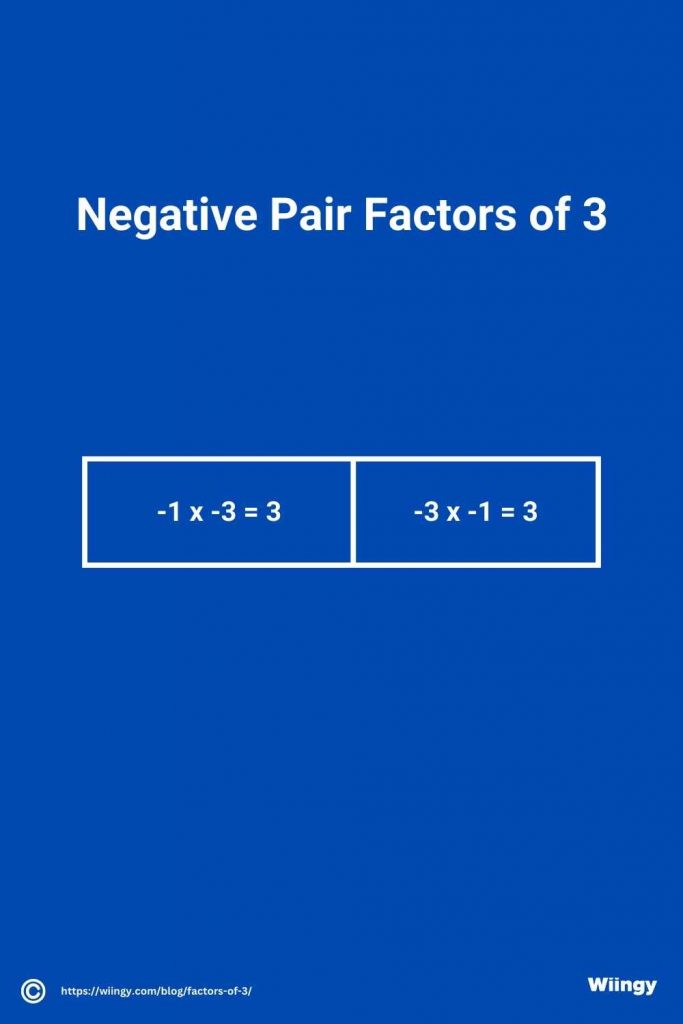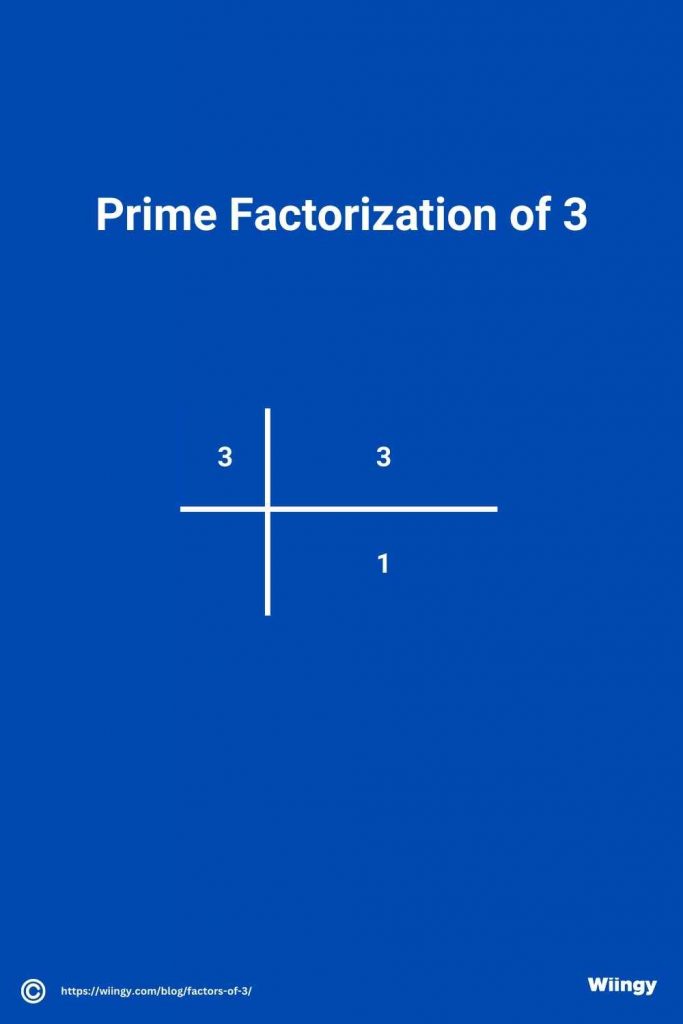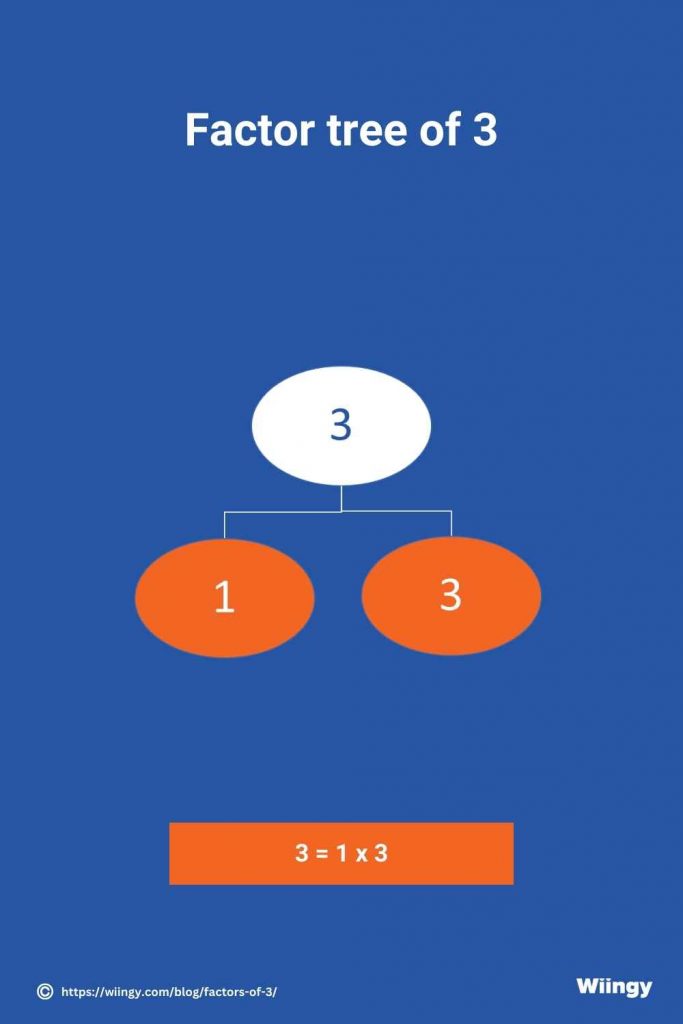Factors
Factors of 3 | Prime Factorization of 3 | Factor Tree of 3
Written by Prerit Jain
Updated on: 12 Aug 2023
Contents
Factors of 3 | Prime Factorization of 3 | Factor Tree of 3
Factors of 3: Factors of a number are those which can divide the given number evenly. They leave behind no remainder. 3 is a prime number. So, it has only two factors that can divide it evenly. These factors are 1 and 3.
All numbers have factors that are positive and negative. They also have pair factors. So, multiplying the set of two factors in pairs gives the original product. We will find the factors of 3 in this article. We will also learn about its prime factorization, and factor trees with examples. Keep reading to learn more.
What Are the Factors of 3?
The factors of 3 can divide the number (3) evenly without leaving any remainder. The factors of a number can be both positive and negative. The number 3 has both positive and negative factors.
Factors of 3: 1, 3
Negative Factors of 3: -1 and -3
Prime Factorization of 3: 1 x 3
Pair Factors of 3: (1, 3)
Prime Factors of 3: 1 and 3
Sum of Factors of 3: 4
Sum of Prime Factors of 3: 4
What Are the Factors of 3 in Pairs?
A pair factor of 3 is two numbers, which when multiplied together gives 3 as the product. They are written as pair factors and also in positive and negative pairs format:
Positive Pair Factors of 3
The positive pair factors of 3 are (1,3), (3,1).

Negative Pair Factors of 3
The negative pair factor of 3 are (-1, -3), (-3, -1)

How to Find Factors of 3 Through Division Method?
We are using the division method to find the factors of 3. In this approach, we will multiply a sequence of natural integers by 3. The numbers that divide the 3 evenly, without leaving any remainder are its factors. The steps below illustrate this method in detail:
• 3 ÷ 1 = 3
• 3 ÷ 3 = 1
We can now see that 1, and 3 are the numbers which do not leave any remainder when divided by 3. So, the factors of 3 are 1 and 3.
What Is the Prime Factorization of 3?
Check if the given number is a prime number. If the given number is a prime number, then it has only two factors: 1 and 3. If the given number is composite, then it has more than two factors.
3 is a prime number and has only two factors. So, we need not employ the prime factorization method to find its factors. But here is an example to provide a clear perspective.
Step 1: Divide the number 3 with the smallest prime number that can divide it. Hence the smallest prime number that is divisible by 3 is 3.
3÷ 3 = 1
Step 2: The quotient is 1. It cannot be divided any further. This brings us to the end of prime factorization.
The prime factors of 3 are 3 X 1 or 3.
Image representation of the prime factorization of 3:

What Is the Factor Tree of 3?
The factor tree can also be used to find the factors of a number. In the case of 3, however, the factor tree is not required. This is because 3 being a prime number, can have only two factors: 1 and 3. But here are detailed steps to draw a factor tree for 3, for a clearer understanding.
Step 1: Let’s place the number 3 on top of the factor tree. Now write down 47 in pairs. The only pair factors for 3 are 1 and 3.
Step 2: Since 3 is a prime number, we can no longer separate it. We cannot separate 1 either. The branches in the factor tree will now be all the prime numbers.
Hence, circling all the branches, 3 or 3 X 1 = 3.
The way to write a factor tree for 3 is as follows.

Solved Examples
Here are some solved examples of 3 factors:
Q1. Discover the common factors of 3 and 2.
Solution
1 and 3 are the two factors of 3.
1 and 2 are the two factors of 2.
Since both the integers 2 and 3 are prime numbers with only two factors. Hence the common factor of 3 and 2 is 1.
Q2. Determine which are the common factors of 6 and 3.
Solution:
1 and 3 are the only two factors of 3.
1, 2, 3 and 6 are the four factors of 3.
Since 3 is a prime number with only two factors but 6 is not a prime number and has 4 factors. Hence the common factors of 6 and 3 are 1 and 3.
Q3. Examine whether 3 is a prime or a composite number.
Solution:
First, let’s discover all the factors of 3.
1 and 3 are the two factors of 3.
If a number can be prime factorized or divided by just two numbers, 1 and the number itself, it is considered a prime number. Whereas a number that can be prime factorized or divided by more than two numbers, it’s considered a composite number.
Therefore, since 3 has just two factors, it is considered a prime number.
Frequently Asked Questions
What will 3 be factorized to?
Given that it is a prime number, just like 1, it will just have two factors, 3 and 1.
Find the prime factors of 3.
3 can be prime factorized as 1 × 3.
Identify the positive and negative pair elements of 3.
(1, 3) and (-1, -3) are the positive and negative pair elements of 3.
Whether 2 can be considered a factor of 3?
The answer is no; 2 cannot be used to factor 3. The division of 3 by 2 results in a remainder of 1, hence 2 is not considered a factor of 3.
What would all the factors of 3 sum up to?
All the factors of 3 would sum up to yield a result of 4. We are highly aware that 1 and 3 are the only two factors of 3.
Hence, the sum of factors of 3 = 1+3 = 4.
Calculate Factors of
The Factors are

Written by
Prerit Jain
